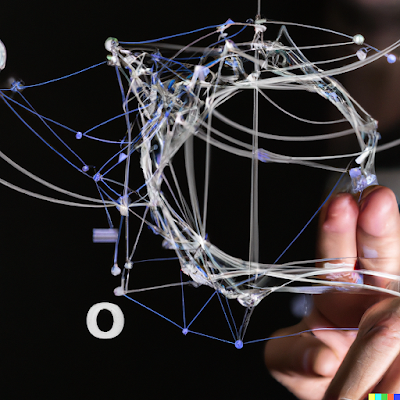The "Web of Data," also known as the "Semantic Web," refers to the idea that Web 3.0 will link and integrate data from different sources in a more seamless and intuitive way, creating a more interconnected web.
The Web of
Data is expected to be built on top of existing web technologies, such as HTML,
CSS, and JavaScript, but will also incorporate new technologies and approaches
to enable the web to understand and process the meaning of the data it
contains. This will allow data and information from different sources to be
linked and integrated in a more seamless and intuitive way, creating a more
interconnected and intelligent web.
Some
potential applications of the Web of Data include:
- More sophisticated and accurate search engines that can understand the context and meaning of queries.
- Enhanced data analytics and visualization tools that can make sense of large and complex data sets.
- More intuitive and interactive
online experiences that can understand and respond to natural language
input
The Web of Data is still in the early stages of development, and many of its capabilities and features are still being explored and refined. However, it is expected to have a significant impact on the way we access and use information on the web, and will be an important component of Web 3.0.
Here are
some examples of how you might use the heading "Web of Data" to
describe the capabilities and features of Web 3.0:
- "Web 3.0 will be a web of data, linking and integrating data from different sources in a more seamless and intuitive way. This will create a more interconnected and intelligent web, enabling more sophisticated and accurate search engines, enhanced data analytics and visualization tools, and more intuitive and interactive online experiences."
- "The Web of Data will be an important component of Web 3.0, enabling data from different sources to be linked and integrated in a more seamless and intuitive way. By creating a more interconnected and intelligent web, the Web of Data will enable more personalized and targeted online experiences, and will help to make sense of large and complex data sets."
- "Web 3.0 will be a web of
data, using advanced technologies such as natural language processing to
understand and process the meaning of data and information on the web. By
linking and integrating data from different sources, the Web of Data will
create a more interconnected and intelligent online environment, with more
sophisticated and accurate search engines and more intuitive and
interactive online experiences."
These
headings suggest that the Web of Data will be an important component of Web
3.0, and will enable a more sophisticated and intelligent online experience by
linking and integrating data from different sources. They also highlight some
of the potential benefits and capabilities of the Web of Data, such as more
accurate search engines, enhanced data analytics and visualization tools, and
more personalized and targeted online experiences.
Some key
features and potential applications of the Web of Data (also known as the
Semantic Web) include:
- Linking and integrating data from different sources: The Web of Data will enable data from different sources to be linked and integrated in a more seamless and intuitive way, creating a more interconnected and intelligent web.
- More sophisticated and accurate search engines: The Web of Data will enable search engines to understand the context and meaning of queries, resulting in more accurate and relevant search results.
- Enhanced data analytics and visualization tools: The Web of Data will enable more sophisticated and effective data analytics and visualization tools, allowing businesses and organizations to make more informed decisions based on data analysis.
- More intuitive and interactive online experiences: The Web of Data will enable more intuitive and interactive online experiences that can understand and respond to natural language input, creating a more immersive and engaging online environment.
- Personalized and targeted online
experiences: The Web of Data will enable more personalized and targeted
online experiences based on individual preferences and behavior, providing
a more tailored and relevant online experience.
Overall, the
Web of Data is expected to have a significant impact on the way we access and
use information on the web, and will be an important component of Web 3.0. Its
key features and potential applications will likely continue to evolve and
change as the concept of the Semantic Web continues to develop.
 |
Web of Data its Protentional Applications |



No comments:
Post a Comment